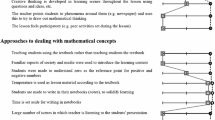Abstract
This paper reports a classroom observation study which intends to characterise the instructional practices in junior secondary mathematics classrooms in Beijing, Hong Kong and London, focusing on the different cultural beliefs pertaining to mathematics and mathematics teaching and learning between the Chinese and Western cultures. The results show that there are striking differences in classroom practices between the three places, and the differences seem to be related to the differences in attitudes towards mathematics and mathematics teaching and learning. The findings point to the potential of the cultural perspective in interpreting results of comparative curriculum studies.
Similar content being viewed by others
References
Bond, M.H. and Huang, K.K.: 1986, ‘The social psychology of Chinese people’, in M.H. Bond (ed.),The Psychology of the Chinese People, Oxford University Press, Hong Kong.
Chang, P.T.: 1984, ‘A comparative study of mathematics education between the Province of Taiwan, Republic of China and the United States’, Pacific Cultural Foundation, Republic of China.
Cunningham, S.: 1984, ‘Cross-cultural study of achievements calls for changes in home’,APA Monitor 15 (9, 10).
Dennis, G. (ed.): 1991,Annual Abstracts of Statistics 1991 No. 127, HMSO, London.
Douglas, J.D. and Wong, A.C.: 1977, ‘Formal operations: Age and sex differences in Chinese and American children’,Child Development 48, 689–92.
Eisner, E.W.: 1985,The Educational Imagination, Collier Macmillan Publishers, London.
Garvey, A. and Jackson, B.: 1975,Chinese Children. Research and Action Project into the Needs of Chinese Children, National Education Research Development Trust, Cambridge.
Hawkins, J.N.: 1983,Education and Social Change in the People's Republic of China, Praeger Publishers, New York.
Hess, R.D., Chang, C.M. and McDevitt, T.M.: 1987, ‘Cultural variations in family beliefs about children's performance in mathematics: Comparisons among People's Republic of China, Chinese-American, and Caucasian-American families’,Journal of Educational Psychology 79 (2), 179–188.
Ho, D.Y.F. and Kang, T.K.: 1984, ‘Intergenerational comparisons of child-rearing attitudes and practices in Hong Kong’,Developmental Psychology 20, 1004–16.
Hoosain, R.: 1979, ‘Forward and backward digit span in the languages of the bilingual’,Journal of Genetic Psychology 135, 263–8.
Huang, J. and Liu, I.: 1978, ‘Paired-associate learning proficiency as a function of frequency count, meaningfulness, and imaginary value in Chinese two-character ideograms’,Acta Psychologica Taiwanica 20, 5–17.
Leestma, R., Bennett, W.J., August, R.L., George, B. and Peak, L.: 1987,Japanese Education Today, A report from the U.S. Study of Education in Japan, Office of Educational Research and Improvement (ED), Washington, DC.
Lin, F.L.: 1988, ‘Social differences and their influences on children's mathematics understanding’,Educational Studies in Education 19, 471–497.
Liu, I.M. and Hsu, M.: 1974, ‘Measuring creative thinking in Taiwan by the Torrance Test’,Testing and Guidance 2, 108–9.
Liu, I.M.: 1984,A Survey of Memorization Requirement in Taipei Primary and Secondary Schools. Unpublished manuscript, National Taiwan University.
Liu, I.M.: 1986, ‘Chinese cognition’, in M.H. Bond (ed.),The Psychology of the Chinese People, Oxford University Press, Hong Kong.
Polya, G.: 1948,How to Solve It? Princeton University Press, Princeton, NJ.
Roberts, D. (ed.): 1989,Hong Kong 1989: A Review of 1988, Government Printer, Hong Kong.
Robitaille, D.F.: 1991,The Third International Mathematics and Science Study: Project Overview,IEA.
Robitaille, D.F. and Garden, R.A. (eds.): 1989,The IEA Study of Mathematics II: Contexts and Outcomes of School Mathematics, Pergamon Press, Oxford.
Sollenberger, R.T.: 1968, ‘Chinese-American child-rearing practices and juvenile delinquency’,Journal of Social Psychology 74, 13–23.
State Education Commission: 1991,Educational Statistics Yearbook of China 1990, People's Education Press, Beijing [in Chinese].
Stevenson, H.W.: 1985,An Analysis of Japanese and American Textbooks in Mathematics, Office of Educational Research and Improvement (ED), Washington, DC.
Stevenson, H.W., Lee, S.Y. and Stigler, J.W.: 1986, ‘Mathematics achievement of Chinese, Japanese, and American children’,Science 231, 693–699.
Stevenson, H.W. and Stigler, J.W.: 1992,The Learning Gap, Summit Books, New York.
Stigler, J.W. and Perry, M.: 1988a, ‘Mathematics learning in Japanese, Chinese, and American classrooms’,New Directions for Child Development 41 (Feb.), 27–54.
Stigler, J.W. and Perry, M.: 1988b, ‘Cross-cultural studies of mathematics teaching and learning: Recent findings and new directions’, in Grouws, D.A. and Cooney, T.J. (eds.),Research Agenda in Mathematics Education: Perspectives on Research on Effective Mathematics Teaching, NCTM, Reston, Virginia.
Sun, L.K.: 1983,The “Deep Structure” of Chinese Culture, Chap Yin Co., Hong Kong [in Chinese].
Taylor, M.J.: 1987,Chinese Pupils in Britain, Windsor.
Travers, K.J. and Westbury, I.: 1989,The IEA Study of Mathematics I: Analysis of Mathematics Curricula, Pergamon Press, Oxford.
Unger, J.: 1982,Education under Mao, Columbia University Press, New York.
Wares, J.G. and Becker, J.P.: 1983, ‘Mathematics education in Chinese middle schools’,School Science and Mathematics 83(1), 39–53.
Weiner, B., Frieze, I., Kukla, A., Reed, L., Rest, S. and Rosenbaum, R.M.: 1971, ‘Perceiving the causes of success and failure’, in Jones, E.E., Kanouse, D.E., Kelly, H.H., Nisbett, R.E., Valins, S. and Weiner, B.,Attribution: Perceiving the Causes of Behavior, General Learning Press, Morristown, NJ.
Yang, K.S.: 1981, ‘Social orientation and individual modernity among Chinese students in Taiwan’,Journal of Social Psychology 113, 159–70.
Author information
Authors and Affiliations
Rights and permissions
About this article
Cite this article
Leung, F.K.S. The mathematics classroom in Beijing, Hong Kong and London. Educ Stud Math 29, 297–325 (1995). https://doi.org/10.1007/BF01273909
Issue Date:
DOI: https://doi.org/10.1007/BF01273909




